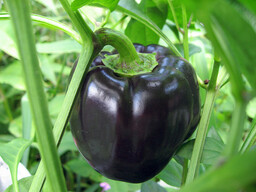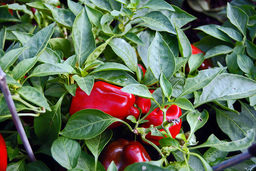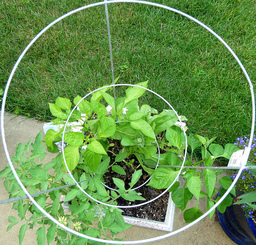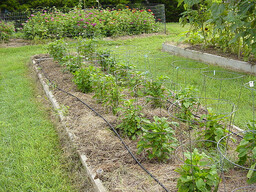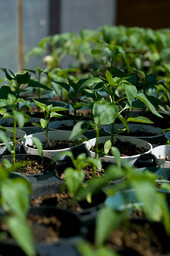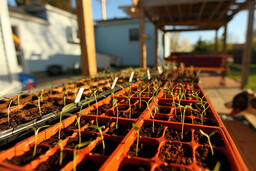Pepper, bell
Description
Uses
Propagation
References
Common Pests and Diseases
Diseases
Category : Fungal
Anthracnose Colletotrichum spp.
Symptoms
Circular lesions on fruit which contain tan to orange to black concentric rings in the center; lesions usually reach 3 cm (1.2 in) in diameter but may enlarge to cover most of the fruit surface; lesions may also occur on leaves and stems and appear as irregularly shaped gray spots with dark margins
Cause
Fungi
Comments
Anthracnose is found in all major vegetable growing areas worldwide and can cause large losses if left untreated
Management
Always plant disease-free seeds and transplants; seeds can be freed from infection by treating with hot water at 52°C (125.6°F) for 30 minutes; if disease is known to present, the field should be rotated with non-susceptible crops for a period of 3 years; plowing crop residue deeply into the soil r removing crop debris can help to reduce inoculum in the soilCercospora leaf spot (Frogeye leaf spot) Cercospora capsici
Symptoms
Initial symptoms of infection are the formation of small, circular, water-soaked spots on leaves, stems, petioles and/or peduncles; the lesions mature to have white to brown centers surrounded by a brown to red or purple border; as the lesions expand, they may develop a water-soaked outer edge and dark outer ring which gives the lesions a concentric appearance; mature lesions are brittle and cracked in the center; lesions may be between 0.3 and 1.3 cm (0.1–0.5 in) in diameter;
Cause
Fungus
Comments
Cercospora leaf spot is mainly a disease of tropical and subtropical countries and occurs mainly in Africa, South America, Asia and the West Indies. In the U.S. it is found mainly in the southestern states
Management
Cercospora infections are usually minor in pepper and require no treatment; crop debris should be removed and destroyed after harvest or buried in the soil; application of an appropriate fungicide can help to reduce damage if applied early on in the infection; practicing crop rotation reduces the incidence of the disease
Damping-off
Pythium spp.
Rhizoctonia solani
Symptoms
Seeds did not germinate; seedlings collapsing and dying; dark stems which are shriveled near the soil line; water-soaked lesions on the stem; water-soaked discolored roots
Cause
Fungi
Comments
Disease can be spread in infected soil and irrigation water; disease emergence favored by overcrowded plants and excessive nitrogen fertilization
Management
Avoid planting in poorly draining, cool, wet soil; planting in raised beds will help with soil drainage; plant high quality seed that germinates quickly; treat seeds with fungicide prior to planting to eliminate fungal pathogensFusarium wilt Fusarium oxysporum most likely
Symptoms
Yellowing of foliage and wilting upper leaves; wilting spread to all parts of plant; leaves remain attached to plant and are dark green in color; red-brown discoloration of vascular tissue; plant death
Cause
Fungus
Comments
Disease emergence favors high soil moisture content
Management
Plant pepper in well draining soils and avoid waterloggingGray leaf spot Stemphylium spp.
Symptoms
Initial symptoms of disease appear as small, red-brown spots on leaves measuring 1–2 mm in diameter; as disease progresses, lesions expand and turn lighter in the center; lesions expand to 3–5 mm in diameter and mature lesions have white or gray centers and red-brown margins; high numbers of lesions may form on leaves causing them to turn yellow and drop from the plant
Cause
Fungi
Comments
Disease has worldwide distribution but is most common in peppers grown in the cool-season in tropical and subtropical climates; pathogen also attacks tomatoes
Management
As pepper nursery beds seem to be more susceptible to gray leaf spot infection, control relies on good management of the beds; beds should be well ventilated and all crop debris should be promptly removed; beds should not be planted next to pepper or tomato fields; if disease is present and spreading then application of appropriate fumigant fungicides should be effective at eradicating the pathogen; lesions on plants in an established field usually do not warrant treatmentPowdery mildew Leveillula taurica
Symptoms
Patches of white, powdery fungal growth on the underside of the leaves; yellow to brown discoloration of the upper leaf; edges of leaves may curl upwards exposing the underside of the leaf; leaves may begin dropping from plant
Cause
Fungus
Comments
Disease can occur in both humid and dry conditions; disease spreads most rapidly in humid conditions; disease commonly affects older leaves
Management
Apply appropriate fungicide if disease is severeSouthern blight Sclerotium rolfsii
Symptoms
Sudden wilting of leaves; yellowing foliage; browning stem above and below soil; browning branches; stem may be covered with fan-like mycelial mat
Cause
Fungus
Comments
Fungus can survive in soil for long periods; disease emergence favored by high temperatures, high humidity and acidic soil; disease found mainly in tropical and subtropical regions, including the southern United States
Management
Remove infected plants; avoid overcrowding plants to promote air circulation; rotate crops with less susceptible plants; plow crop debris deep into soil; provide a barrier to infection by wrapping lower stems of plant with aluminum foil covering below ground portion of stem and 2-3 in above soil lineVerticillium wilt Verticillium spp.
Symptoms
Initial symptoms of the disease include plants becoming stunted and lower leaves turning yellow; as the infection progresses, more leaves turn yellow and begin dropping from the plant; plants wilt during the day and recover at night; wilting becomes permanent and plant death ensues.
Cause
Fungi
Comments
Disease is present in pepper grown in Europe, Canada and the U.S.; the severity of the disease when it emerges is dependent on many factors, including the strain of the pathogen, host susceptibility, soil type and prevailing climatic conditions
Management
There are currently no effective control strategies for Verticillium wilt once it is present in the field; cultural control practices should be employed to lessen the chances of the disease emerging in the first place; management strategies include rotating the crop every 3–4 years away from pepper; soil fumigation and/or solarization can reduce the level of inoculant in the soilCategory : Bacterial
Bacterial canker Clavibacter michiganensis
Symptoms
Small, raised, white lesions on leaves that grow larger, turn brown and necrotic and may have a yellow halo; raised white lesions on fruit which coalesce to form larger spots, often with white halo
Cause
Bacterium
Comments
Symptoms can be mistaken for bacterial spot; disease emergence favors high temperatures and high humidity; disease can be spread between peppers and tomatoes
Management
Use only certified seed and disease free transplants; treat seeds with hot water prior to planting to kill bacteria; sanitize all equipment regularly; rotate crops with non-solanaceous plants
Bacterial spot
Xanthomonas campestris
Xanthomonas euvesicatoria
Xanthomonas perforans = [Xanthomonas axonopodis (syn. campestris) pv. vesicatoria]
Xanthomonas vesicatoria
Xanthomonas gardneri
Symptoms
Water-soaked lesions that dry out and turn brown forming on the underside of the leaves; raised brown cankers on stems; cracked brown lesions on fruit.
Cause
Bacterium
Comments
Disease emergence favored by warm, wet conditions; the pathogen can be enter a field on seed and transplants and can be spread within a field by wind-driven rain, clipping plants and aerosols.
Management
Use disease free planting material; remove and destroy all crop debris after harvest, or plow material deeply under soil.Bacterial wilt Ralstonia solanacearum
Symptoms
Upper leaves of plant wilt on hot days and recover in the evening and early morning; affected leaves remain green and attached to the plant; if conditions are favorable to the development of the disease then the entire plant may wilt; vascular tissue in lower stems is often discolored brown; severe infection may result in bacteria oozing from the stems; symptoms are often found associated with low lying areas of fields where water collects
Cause
Bacteria
Comments
Most major losses in pepper crop are incurred in tropical and subtropical growing regions; disease also affects tomato, potato, tobacco and eggplant crops; bacteria enter the plants through tiny wounds in roots
Management
Bacterial wilt is very difficult to control once it is established in a field; cultural control methods include planting disease-free seedlings and ensuring irrigation water is free of the pathogen; plants should not be irrigated excessively to prevent build-up of water which favors the development of the disease; pepper should be rotated with non-susceptible crops to prevent the build up of the pathogen in the soilCategory : Other
Blossom-end rot n/a
Symptoms
Small water-soaked area on end of fruit where the blossom was occurring or on the side of unripe fruit; lesion enlarges and turns sunken, tan brown and leathery in appearance
Cause
Low calcium concentration in fruit
Comments
Physiological disorder; low calcium may result from competition from other ions in soil e.g. potassium; can also be caused by drought stress; fluctuations in soil moisture or application of excessive amounts of nitrogen fertilizer which promotes rapid vegetative growth
Management
Maintain soil pH at 6.5; lime soil to increase the concentration of calcium in soil and decrease competition with other ions; use mulch to reduce drought stress; avoid ammonium fertilizers as they may increase competition with calcium by increasing ammonium ions in soil, use nitrate instead; avoid over fertilizingMagnesium deficiency
Symptoms
Symptoms of magnesium deficiency appear on older leaves first; initial symptoms are interveinal chlorosis of the leaves and, occasionally, a purple tinge to the leaves; as the deficiency becomes more severe, leaves may appear white with green veins; severe deficiencies may lead to reduced fruit yield
Cause
Nutritional disorder
Comments
Magnesium deficiency is rare in field grown peppers but can arise in sandy soils when heavy rain causes leaching
Management
Magnesium deficiency can be prevented by applying dolomite lime to the soil, if an increase in soil pH is required, or through applications of a fertilizer containing magnesiumNitrogen deficiency
Symptoms
Plants exhibit reduced growth and leaves are smaller than normal; leaves exhibit a general yellowing; fruit are reduced in size and pale in color; older leaves of the plant show symptoms first and the yellowing progresses to younger leaves
Cause
Nutritional disorder
Comments
Nitrogen deficiency usually arises in cmmercial plantations through inadequate fertilizer application; heavy rain can leach nitrogen from sandy soils
Management
If detected early, symptoms of nitrogen deficiency can be treated by applying appropriate amounts of nitrogen fertilizerCategory : Viral
Mosaic
Cucumber mosaic virus (CMV)
Potato virus Y (PVY)
Symptoms
Alternating light and green areas or mosaic patterns on the leaves; leaves distorted and curled; slow plant growth
Cause
Virus
Comments
Transmitted by aphids; weeds can act as a source of inoculum; insecticides are not effective due to the speed with which aphids can transmit the virus
Management
Remove weeds around crop; use reflective mulches to deter aphids from plantsTomato spotted wilt virus Tomato spotted wilt virus (TSWV)

In addition to chlorosis leaves may also become twisted and distorted. The severity and appearance of symptoms will vary depending on the cultivar, the age of the plant at the time of infection, environmental conditions and the virus isolate.
Symptoms
Symptoms may vary widely depending on variety and environmental conditions; generally leaves become spotted and bronzed in appearance; plant may droop or wilt; fruit develop concentric rings which are light in color and become necrotic
Cause
Virus
Comments
Virus can infect a wide range of plants including crops, ornamentals and weeds; once acquired by the thrips vector, the insect is capable of transmitting the virus for the rest of its life
Management
Management of the disease is aimed at control of the thrips vector (see Thrips)Category : Oomycete
Phytophthora blight Phytophthora caspsici
Symptoms
Black lesions on stems; wilting plant; circular gray-brown lesions on leaves; dark lesions on fruit which may be covered in white sporangia
Cause
Oomycete
Comments
Disease highly water dependent and spores can be spread by water splash; disease can move root to root to infect a row of plants
Management
Plant disease free transplants; manage water carefully as pathogen depends on water for survival; rotate crops; apply appropriate fungicidePests
Category : Insects
Aphids Myzus persicae
Symptoms
Small soft bodied insects on underside of leaves and/or stems of plant; usually green or yellow in color, but may be pink, brown, red or black depending on species and host plant; if aphid infestation is heavy it may cause leaves to yellow and/or distorted, necrotic spots on leaves and/or stunted shoots; aphids secrete a sticky, sugary substance called honeydew which encourages the growth of sooty mold on the plants
Cause
Insect
Comments
Distinguishing features include the presence of cornicles (tubular structures) which project backwards from the body of the aphid; will generally not move very quickly when disturbed
Management
If aphid population is limited to just a few leaves or shoots then the infestation can be pruned out to provide control; check transplants for aphids before planting; use tolerant varieties if available; reflective mulches such as silver colored plastic can deter aphids from feeding on plants; sturdy plants can be sprayed with a strong jet of water to knock aphids from leaves; insecticides are generally only required to treat aphids if the infestation is very high - plants generally tolerate low and medium level infestation; insecticidal soaps or oils such as neem or canola oil are usually the best method of control; always check the labels of the products for specific usage guidelines prior to useBeet armyworm Spodoptera exigua
Symptoms
Singular, or closely grouped circular to irregularly shaped holes in foliage; heavy feeding by young larvae leads to skeletonized leaves; shallow, dry wounds on fruit; egg clusters of 50-150 eggs may be present on the leaves; egg clusters are covered in a whitish scale which gives the cluster a cottony or fuzzy appearance; young larvae are pale green to yellow in color while older larvae are generally darker green with a dark and light line running along the side of their body and a pink or yellow underside
Cause
Insect
Comments
Insect can go through 3–5 generations a year
Management
Organic methods of controlling the beet armyworm include biological control by natural enemies which parasitize the larvae and the application of Bacillus thuringiensis; there are chemicals available for commercial control but many that are available for the home garden do not provide adequate control of the larvaeColorado potato beetle Leptinotarsa decemlineata
Symptoms
Feeding damage to foliage; if infestation is severe or if left untreated plants can be completely defoliated; adult insect is a black and yellow striped beetle; larvae are bright red with black heads when they first hatch and change color to pink; larvae have two rows of black spots
Cause
Insect
Comments
Adult beetles emerge in spring; female beetles lay eggs in batches of up to two dozen; eggs are orange-yellow and are laid on undersides of leaves; a female can lay 500 or more eggs over a four to five week period
Management
Control of Colorado potato beetle can be challenging as they have developed high levels of insecticide resistance; in the home garden planting early maturing varieties of potato allows the plants to escape from most damage; adults and larvae should be hand picked from plants and destroyed in soapy water; applications of Bacillus thuringiensis can be effective at controlling larvae but should be applied frequently; some insecticides, including spinosad, are still effective against adult beetlesFlea beetles Various
Symptoms
Small holes or pits in leaves that give the foliage a characteristic “shothole” appearance; young plants and seedlings are particularly susceptible; plant growth may be reduced; if damage is severe the plant may be killed; the pest responsible for the damage is a small (1.5–3.0 mm) dark colored beetle which jumps when disturbed; the beetles are often shiny and metallic in appearance
Cause
Insects
Comments
Flea beetles may overwinter on nearby weed species, in plant debris or in the soil; insects may go through a second or third generation in one year
Management
In areas where flea beetles are a problem, floating row covers may have to be used prior to the emergence of the beetles to provide a physical barrier to protect young plants; plant seeds early to allow establishment before the beetles become a problem - mature plants are less susceptible to damage; trap crops may provide a measure of control - cruciferous plants are best; application of a thick layer of mulch may help prevent beetles reaching surface; application on diamotecoeus earth or oils such as neem oil are effective control methods for organic growers; application of insecticides containing carbaryl, spinosad, bifenthrin and permethrin can provide adequate control of beetles for up to a week but will need reappliedLeafminers Lyriomyza spp.
Symptoms
Thin, white, winding trails on leaves; heavy mining can result in white blotches on leaves and leaves dropping from the plant prematurely; early infestation can cause fruit yield to be reduced; adult leafminer is a small black and yellow fly which lays its eggs in the leaf; larave hatch and feed on leaf interior
Cause
Insects
Comments
Mature larvae drop from leaves into soil to pupate; entire lifecycle can take as little as 2 weeks in warm weather; insect may go through 7 to 10 generations per year
Management
Check transplants for signs of leafminer damage prior to planting; remove plants from soil immediately after harvest; only use insecticides when leafminer damage has been identified as unnecessary spraying will also reduce populations of their natural enemiesLeafroller (Omnivorous leafroller) Platynota stultana
Symptoms
Leaves of plant rolled and tied together with silk webbing; feeding damage to rolled leaves; defoliation of plant; silk webbing may also be present on fruits and fruits may have substantial scarring from feeding damage; larvae wriggle vigorously when disturbed and may drop from plant on a silken thread
Cause
Insect
Comments
Adult insect is a moth which can fly over several miles to find suitable hosts; alfalfa and sugar beet are good hosts
Management
Monitor plants regularly for signs of infestation; remove weeds from plant bases as they can act as hosts for leafrollers; avoid planting pepper in areas where sugarbeet or alfalfa are grown nearby; Bacillus thuringiensis or Entrust SC may be applied to control insects on organically grown plants; apply sprays carefully to ensure that treatment reaches inside rolled leavesPepper weevil Anthonomus eugenii
Symptoms
Feeding damage to foliage, buds and tender young fruit pods; larvae feed within buds and fruit; older fruit misshapen and discolored; buds and fruit may drop from plant; adult weevil is a small black beetle; larvae are small cream-white grubs with brown heads which can reach 0.6 cm (0.25 in) in length when mature
Cause
Insect
Comments
Weevil will go through multiple generations per year; pepper preferred host but weevil will feed on other plants in the nightshade family also
Management
Remove any nightshade plants growing in close proximity to pepper; immediately remove any dropped fruit from soil surface; if pepper weevil becomes problematic, rotate crop the following year; organically acceptable control methods include sprays of pyrethrin; destroy pepper crop residue immediately after harvest
Thrips (Western flower thrips, Onion thrips, etc.)
Frankliniella occidentalis
Thrips tabaci
Symptoms
If population is high leaves and buds may be distorted; leaves appear silvery and are speckled with black feces; insects will feed on and damage flowers; most damage occurs through the transmission of Tomato spotted wilt virus (TSWV); insect is small (1.5 mm) and slender and best viewed using a hand lens; adult thrips are pale yellow to light brown and the nymphs are smaller and lighter in color
Cause
Insect
Comments
Insect transmits Tomato spotted wilt virus (see disease entry); once acquired, the insect retains the ability to transmit the virus for the remainder of its life
Management
Avoid planting next to onions, garlic or cereals where very large numbers of thrips can build up; use reflective mulches early in growing season to deter thrips; apply appropriate insecticide if thrips become problematicTomato fruit worm (Corn earworm) Helicoverpa zea
Symptoms
Larvae burrowing into fruit near stem end and feeding on fruit interior causing decay; fruit turn red prematurely and fall from plant causing reduced yield; young caterpillars are cream-white in color with a black head and black hairs; older larvae may be yellow-green to almost black in color with fine white lines along their body and black spots at the base of hairs; eggs are laid singly on both upper and lower leaf surfaces and are initially creamy white but develop a brown-red ring after 24 hours and darken prior to hatching
Cause
Insect
Comments
Adult insect is a pale green to tan, medium sized moth; can be one of the most damaging pests of tomato; insect overwinters as pupae in the soil; the insect is also a damaging pest of corn and is also referred to as the corn earworm
Management
Early treatment of tomato fruitworms is necessary as once they enter the fruit they are protected from sprays; monitor plants for eggs and young larvae and also natural enemies that could be damaged by chemicals; Bacillus thuringiensis or Entrust SC may be applied to control insects on organically grown plants; appropriate chemical treatment may be required for control in commercial plantationsCategory : Mites
Spider mites (Two spotted spider mite) Tetranychus urticae
Symptoms
Leaves stippled with yellow; leaves may appear bronzed; webbing covering leaves; mites may be visible as tiny moving dots on the webs or underside of leaves, best viewed using a hand lens; usually not spotted until there are visible symptoms on the plant; leaves turn yellow and may drop from plant
Cause
Arachnid
Comments
Spider mites thrive in dusty conditions; water-stressed plants are more susceptible to attack

